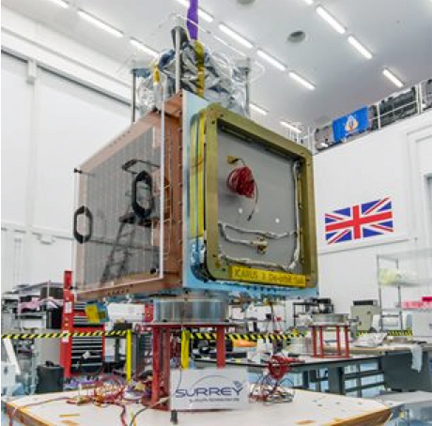[Satnews] Surrey Satellite Technologies Ltd. (SSTL) CARBONITE-1, the microsatellite the company launched in July, has been shortlisted for an Innovation Award by the Institute of Engineering and Technology.
There were more than 300 entrants from 28 countries and stiff competition in this category from the likes of NATS and Lockheed Martin, QinetiQ, Selex ES and the Horace Hearne Jr. Institute for Theoretical Physics at Louisiana State University.

CARBONITE-1 uses commercial-off-the-shelf industrial camera systems, novel mechanisms, rapid-build manufacturing techniques and the use of spare capability on the launch rocket to deliver video from space.
The genesis of the CARBONITE-1 mission was another of SSTL's “light-bulb” moments when the firm realized there was a small amount of spare capacity on the launch they had booked for their DMC3 satellites on ISRO’s PSLV-XL launch vehicle. There was just enough space left in the upper stage for a microsatellite if SSTL was careful with the size and weight, so the company grabbed the opportunity to test out some of their new Earth Observation (EO) ideas.
A small mission team was pulled together that consisted of an eclectic mix of engineers—some very senior with many years of experience, working alongside some recent graduates. The team had to work within a very tight timeframe of just six months for the full design, build and test campaign—in fact, they went over by 12 days, but they managed to get a completely new space mission off the drawing board and into the flight case, ready for shipping to the launch site.
For the CARBONITE-1 mission, a high performance amateur telescope and industrial camera were purchased. The telescope was stripped down and a lightweight carbon fiber metering system was designed for rapid manufacture, alignment and assembly. Then a simple design was incorporated into the payload to allow the telescope to be focused with a simple mechanism, once on orbit. The design also had to be robust enough to withstand launch vibration and the transition from 1g to 0g as well as cope with the thermal variations seen in orbit.

CARBONITE-1 flight ready in SSTL's cleanroom.
Photo is courtesy of SSTL.
CARBONITE-1’s platform design had to be constrained to fit within the available space on the launch vehicle. SSTL is quite used to handling size and weight conundrums for the varied space missions that are designed for their customers, but this time there was an added challenge: in order to use the available space on the launcher, SSTL had to also design a unique deployment mechanism that would push the spacecraft off to the side, rather than the usual “release and push” type of deployment.
The SSTL engineers made a bespoke and unique deployment mechanism just for CARBONITE-1, which worked perfectly, propelling the spacecraft away from the launch vehicle at just the correct angle and momentum to start its new life on orbit.
SSTL is grateful to ISRO and Antrix for allowing the company to use the spare capacity on the rocket and for accommodating the SSTL deployment mechanism. Without their co-operation, the CARBONITE-1 mission would never have gotten off the ground—pun fully intended.
CARBONITE-1 will join other Innovation Award finalists in London on November 18, at a prestigious awards dinner and ceremony, where Gadget Show presenter Ortis Deley will announce the winners.
Article is courtesy of SSTL's Space Blog.
For the CARBONITE-1 mission, we purchased a high performance amateur telescope and industrial camera. The telescope was stripped down and a lightweight carbon fibre metering system was designed for rapid manufacture, alignment and assembly. We came up with an ingenious but simple design to allow the telescope to be focussed with a simple mechanism once in orbit. It also had to be robust enough to withstand launch vibration and transition from 1g to 0g, and cope with the thermal variations seen in orbit.
CARBONITE-1’s platform design had to be constrained to fit within the available space on the launch vehicle. We are used to handling size and weight conundrums for the varied space missions that we design for our customers, but this time we had an added challenge: in order to use the available space on the launcher we had to also design a unique deployment mechanism that would push our little spacecraft off to the side rather than the usual “release and push” type of deployment. Our engineers rose to the challenge and made a bespoke and unique deployment mechanism just for CARBONITE-1, and we’re glad to say that it worked perfectly, propelling the spacecraft away from the launch vehicle at just the right angle and with the right amount of momentum to begin its new life in orbit.
We are obviously extremely grateful to our friends at ISRO and Antrix for allowing us to use the spare capacity on the rocket, and for accommodating our deployment mechanism – without their co-operation, the CARBONITE-1 mission would never have got off the ground - pun fully intended.
CARBONITE-1 will join other Innovation Award finalists in London on 18 November, at a prestigious awards dinner and ceremony, where Gadget Show presenter Ortis Deley will announce the winners. Fingers crossed!


